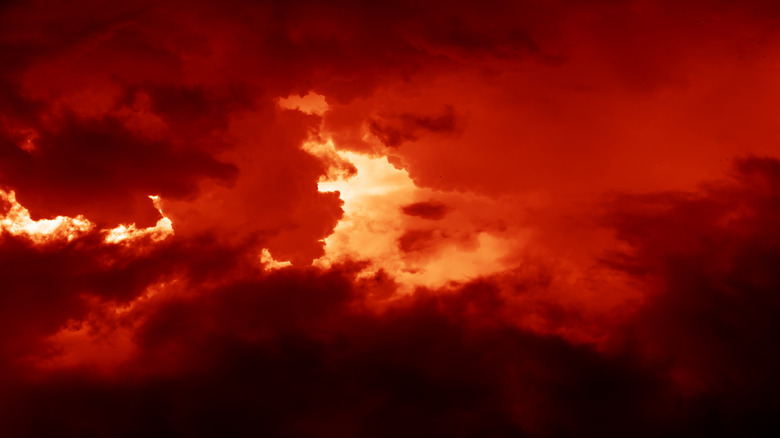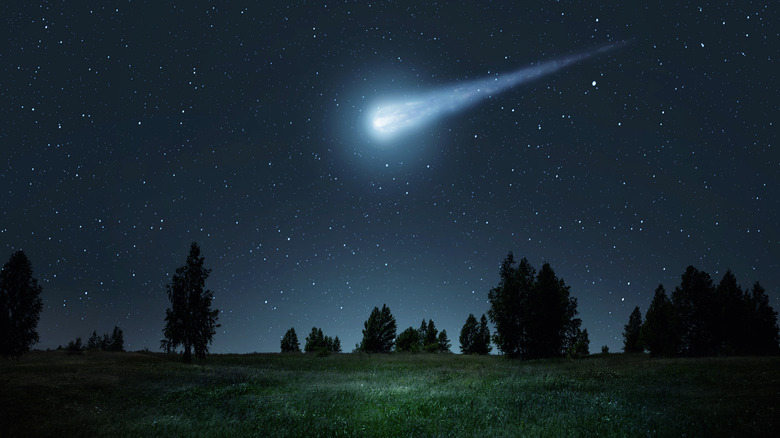The Strange Time Blood Rain Fell From The Sky In India
It was like something out of a sci-fi film, or perhaps a fantasy involving an ancient curse: On July 25, 2001, Kerala, India's rains pooled across the city in a blood-red hue. The people of the city were perplexed, and speculations arose involving everything from pollution to extraterrestrial life. Leading up to the mysterious rains, Malabar residents heard an explosive boom followed by a flash of light. When the blood rain came, pools turned to heavy floods, which affected the city for two months (via Explorersweb).
Along the coast, the rain dyed people's clothes a shade of pink and, most curiously, scorched tree leaves. Scientists and the public alike were stumped, but some believed alluvial forces had swept Arabian dust into the Kerala district, thus tainting the color of the rain. For others, this explanation fell short. At Cochin University of Science and Technology, physicist Godfrey Louis analyzed samples of the rain and concluded that dust wasn't the culprit. Instead, he concluded that the sample was teeming with bacteria from a comet (via The Guardian).
The Extraterrestrial Theory
Dr. Godfrey Louis theorized that the red rain of India was actually an unlikely extraterrestrial visitation. With sci-fi films sending aliens to Earth in steel ships, pods, and even blobs, few would have expected a microbial freefall — but Louis was convinced. In regard to the particles in the sample, he said (via The Guardian) that "they have a clear biological appearance." Furthermore, he intrigued other scientists with his hypothesis. Sheffield microbiologist Milton Wainwright tested a sample of the rain and found that it was not dust; and while no DNA was present, Wainwright suggested that might not be necessary to prove Louis' explanation (via The Guardian).
Louis' research was published, but not in a peer-reviewed journal. In it, he posited that the noise and bright light reported in Malabar were caused by a meteor that combusted and sent otherworldly bacteria into a rain cloud. If this were true, he believed it would lend support to "panspermia" — the hypothesis that microbes could hitch a ride on asteroids and comets and seed many planets with life upon entering their atmospheres. Naturally, Louis' bold paper was met with derision from many scientists, despite interesting journalists and the public (via Discover Magazine).
The Blood Rain Mystery Explained?
A 2006 article in New Scientist put forth multiple theories from experts. One stated that Rhodophyceae, also known as red algae, caused the red rain in India; another implicated possible slaughterhouse waste in the waters; and another suggested liposomes from burning red oil from a ship or an aircraft oil tank. Despite these down-to-earth explanations, the media still favored extraterrestrials.
The year of the blood rain in India, the Ministry of Health made a sober report that was largely ignored (via The Watchers News). They said the phenomenon was caused by algae in the genus Trentepohlia. The midlands and highlands of the region were rich in vegetation, and the samples of the rain showed that the spores were local (via Centre for Earth Science Studies). Although the report left some mysteries open, including a conclusive reason why the anomaly occurred when it did, the lab results seemed to close the case. But in the months and years to follow, the speculations of Dr. Godfrey Louis and other researchers overshadowed the Ministry of Health's report, and the wonderment of the incident persists to this day.


